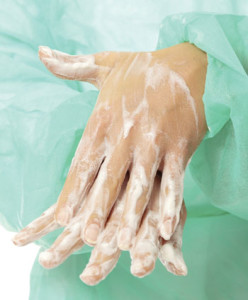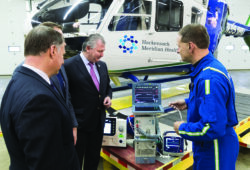Strategies for Increasing HCAHPS Scores
The healthcare industry is putting a new premium on high-quality customer service now that the Centers for Medicare and Medicaid Services (CMS) has implemented pay-for-performance programs and started giving financial incentives to providers with high patient satisfaction ratings. If patient assessments of a hospital’s quality of service fall below a certain level on the HCAHPS (Hospital Consumer Assessment of Healthcare Providers and Systems) survey, that provider may face financial penalties. The rising popularity of new convenient care options—such as retail walk-in clinics found at many grocery and drugstore chains—further threatens hospitals that take quality customer service and patient care for granted.
Not only can high-quality customer service prevent Affordable Care Act-related financial penalties, but it can also reduce malpractice costs, improve an institution’s reputation and encourage patients to choose one facility over another.
But what exactly can facilities do to improve the care experience and patients’ impressions of their service? Many have started providing customer service training for physicians, nurses and other employees. Several healthcare organizations have also begun hiring “patient experience” consultants and designating specific staff members to handle complaints, the Wall Street Journal reports.
Increasingly, technology—in the form of smartphone apps, social media tools and Web-based patient portals—is being employed to create efficiencies and a more interactive care experience. Teaching healthcare providers how to improve their communication skills, humanize their approach to patient care and enhance their bedside manner is also proving to be a successful strategy for upping patient satisfaction scores. Finally, maintaining an above-reproach cleanliness level goes a long way toward keeping patients satisfied—as well as safe from hospital-acquired infections.
Embrace Technology
One in five Americans use social media as a healthcare resource, according to a survey by the National Research Corporation. Social media can give hospital personnel an opportunity for two-way communication and interaction with patients, staff and physicians. For example, Facebook and Twitter can be used to:
• Post health education videos
• Share new and relevant studies and statistics
• Answer general questions from patients
• Advertise and promote upcoming events
While social media is a helpful tool for providing general information, more and more patients are looking to gain access to personal health information and communicate with their physicians online.
Many hospitals have employed secure, Web-based patient portals to meet these demands. Such a portal typically allows patients to view notes from office visits, lists of medications and immunizations, and lab results. Some portals also allow patients to email a physician or nurse, request prescription refills, schedule appointments, complete medical forms, read educational material and make payments.
Hospital Corporation of America (HCA) has deployed patient portals for hospital patients and many physician practices. “They have been very popular with patients,” says Jane Englebright, Ph.D., RN, CENP, FAAN, chief nurse executive, patient safety officer and senior vice president, HCA.
Similar to Web-based patient portals are new smartphone apps with several of the same features. A recent FICO survey of more than 2,000 smartphone users discovered that 80 percent of users want to interact with doctors on their mobile devices. In early 2015, Practice Unite, a HIPAA-compliant mobile application platform for healthcare organizations, announced a new smartphone app for patients. Designed for use in a hospital setting, this app promises to increase patient satisfaction ratings.
Improve Communication
Leading healthcare providers such as HCA have discovered that improving communication between physicians and patients results in a better overall patient experience. Healthcare professionals are always pressed for time, so discussions with patients and families can often be too brief and impersonal. Many communication issues can be solved through etiquette-based communication training—essentially turning what could be a brusque encounter into a friendlier, more conversational meeting.
In this model, physicians introduce themselves, explain their role in the patient’s care, and talk with the patient while asking open-ended questions and touching the patient with a gentle pat on the back, handshake, etc. The protocol helps patients feel they are receiving warm, personal care.
 Healthcare providers can facilitate these encounters by placing chairs in patient rooms for the physician’s use, posting pictures of the care team in the patient’s room, and adding etiquette-based communication reminders to employee manuals and regular training.
Healthcare providers can facilitate these encounters by placing chairs in patient rooms for the physician’s use, posting pictures of the care team in the patient’s room, and adding etiquette-based communication reminders to employee manuals and regular training.
As for patients, educating them on procedures and tests they have to undergo, and giving them ways to strengthen and maintain their health, are critical to improving their experience. Healthcare providers can offer numerous resources, including printed materials, group classes and DVD presentations. Many of these tools are available for download or purchase from organizations such as the American Medical Association, Centers for Disease Control and Prevention, and the Agency for Healthcare Research and Quality.
Most important, however, is for physicians and nurses to take the time to discuss patients’ questions and concerns. A pamphlet or DVD is useful as a reference, but face-to-face conversation makes patients feel they are receiving better, more personal care.
With patient satisfaction becoming increasingly important to the success or failure of healthcare providers, those that begin to improve the patient experience now will be better prepared to meet future expectations.
Ensure Cleanliness
While cleanliness is not the only indicator of a hospital’s quality, it is an important factor—and an area that patients are asked to rate and evaluate on HCAHPS surveys. “The cleanliness and appearance of the hospital has a tremendous effect on patient satisfaction scores,” says Andy Gill, director of contracting and purchased services at HealthTrust.
“While cleanliness is not the only indicator of a hospital’s quality, it is an important factor—and an area that patients are asked to rate and evaluate on HCAHPS surveys. “The cleanliness and appearance of the hospital has a tremendous effect on patient satisfaction scores.”
— Andy Gill, director of contracting and purchased services at HealthTrust
But it’s not just sparkling floors and fresh linens that influence a patient’s rating. Gill explains that environmental service (EVS) providers are trained to interact with patients. Using a model script, housekeepers are taught to introduce themselves, give a brief explanation of the cleaning process and then thank the patient. Oftentimes, Gill says, placards are placed in hospital rooms informing patients of who cleaned their room.
A clean environment also reduces the amount of healthcare-associated infections (HAI), Gill adds. According to the Centers for Disease Control and Prevention, one in 25 hospital patients has at least one HAI on any given day. These HAIs affect hospitals financially, too. CMS no longer provides reimbursement to hospitals for care given to patients with a hospital-acquired illness or infection.
To ensure cleanliness and provide quality assurance, EVS suppliers are going the extra mile by randomly testing patient rooms, halls and bathrooms for bacterial DNA, Gill says. In adenosine triphosphate (ATP) monitoring, the tester swabs a surface, inserts the swab into a handheld device and gets a reading on ATP levels. High ATP levels could be an indicator of infectious materials. Fluorescent dyes are also used to highlight any areas that may not have been cleaned thoroughly.
Share Email





